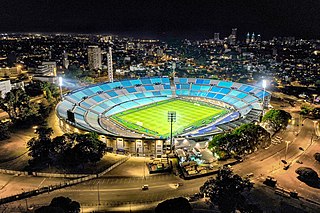
The Argentina national football team, nicknamed La Albiceleste, represents Argentina in men's international football and is administered by the Argentine Football Association, the governing body for football in Argentina.

Teófilo Juan Cubillas Arizaga is a Peruvian former footballer who played as an attacking midfielder. He was selected as Peru's greatest ever player in an IFFHS poll, in which he was also included in the world's Top 50. He was renowned for his technique, shooting ability and free kick ability.

The Uruguay national football team, nicknamed La Celeste, represents Uruguay in international men's football, and is administered by the Uruguayan Football Association, the governing body for football in Uruguay.

The Chile national football team, nicknamed La Roja, represents Chile in men's international football competitions and is controlled by the Federación de Fútbol de Chile which was established in 1895. Chile has appeared in nine World Cup tournaments and were hosts of the 1962 FIFA World Cup where they finished in third place, the highest position the country has ever achieved in the World Cup.

Estadio Centenario is a stadium in the Parque Batlle of Montevideo, Uruguay, used primarily for staging football matches. It is owned by the Montevideo Department. The stadium was built between 1929 and 1930 to host the inaugural 1930 FIFA World Cup, as well as to commemorate the centenary of Uruguay's first constitution. It is listed by FIFA as one of the football world's classic stadiums. On 18 July 1983, it was declared by FIFA as the first Historical Monument of World Football, to this day the only building to achieve this recognition worldwide.

Lorenzo Fernández, nicknamed El Gallego, was a Spanish-born Uruguayan footballer. During his career, he played for Capurro, River Plate, Montevideo Wanderers FC and C.A. Peñarol. Fernández also played 31 times and scored 4 goals for the Uruguay national football team, with which he won the 1930 FIFA World Cup, the gold medal at the 1928 Summer Olympics, and the 1926 and 1935 Copa Americas. A center-half in the 2–3–5 footballing system, he once replaced Pedro Cea as an inside-left forward against Peru during a match in 1929 South American Championship and went on to score a hat-trick.

Juan Humberto Valdivieso Padilla was a Peruvian football goalkeeper and manager.
Adalbert Deșu was a Romanian football striker. He was a member of Romania national football team which competed at the 1930 FIFA World Cup in Uruguay. Deșu was also the first scorer for Romania at a FIFA World Cup. He scored a goal in the first minute of his team's first group game of the first football world cup.

László Raffinsky was a Romanian football player of Hungarian ethnicity who was a member of Romanian team which participated at the 1930 FIFA World Cup in Uruguay and 1938 FIFA World Cup in France. He holds the record for most goals scored in a Liga I match, having scored ten goals in the match between Juventus București and Dacia Unirea Brăila in the 1929–1930 season.
Football is the most popular sport in Peru. Football/soccer in Peru was introduced by British immigrants, Peruvians returning from Great Britain, and by English sailors in the later half of the 19th century during their frequent stops at the port of Callao, which at that point was considered one of the most important ports of the Pacific Ocean. According to the work entitled La Difusión del Fútbol en Lima, during the last decade of the 19th century, records show that sailors were known to practice sports such as football/soccer and played against teams made up of Englishmen, Peruvians, or a mix between Englishmen and Peruvians.
Jorge Ernesto Pardón García was a Peruvian footballer who played for Peru at the 1930 FIFA World Cup. He also played for Sporting Cristal.
Lizardo Rodríguez Nue was a Peruvian footballer who played for Peru at the 1930 FIFA World Cup. He also played for Sport Progreso. Rodríguez is deceased.
Arturo Fernández Meyzán was a Peruvian football defender who played for Peru in the 1930 FIFA World Cup. He also played for Universitario de Deportes, and for Peru at the 1936 Summer Olympics.
Juan Alfonso Valle was a Peruvian football midfielder who played for Peru in the 1930 FIFA World Cup. He also played for Circolo Sportivo Italiano.
Alberto Luis Denegri Aspauza was a Peruvian football midfielder who played for Peru in the 1930 FIFA World Cup. He also played for Universitario de Deportes.
Domingo García Heredia was a Peruvian football midfielder who played for Peru in the 1930 FIFA World Cup. He also played for Alianza Lima.

José María Lavalle Covarrubias was a Peruvian football forward who played for Peru in the 1930 FIFA World Cup. He also played for Alianza Lima.
Demetrio Neyra Ramos was a Peruvian football forward who played for Peru in the 1930 FIFA World Cup. He also played for Alianza Lima.

Jorge Sarmiento Koochoi was a Peruvian football forward who played for Peru in the 1930 FIFA World Cup. He also played for Alianza Lima.
Alberto Soria Ortega was a Peruvian football defender who played for Peru in the 1930 FIFA World Cup.










